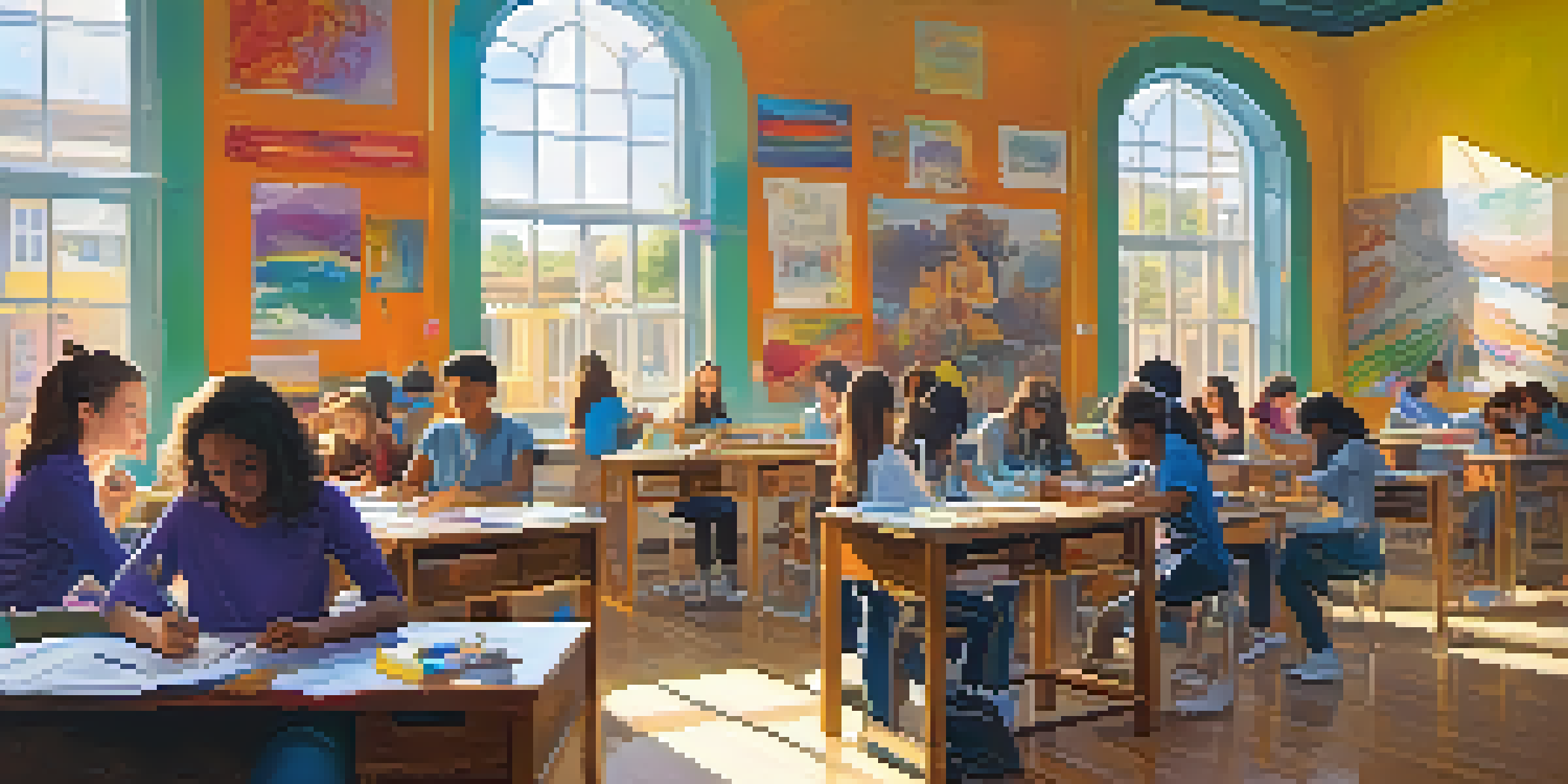The Growth of California's Arts Education and Community Programs

The Historical Context of Arts Education in California
California has a rich history when it comes to arts education, dating back to the early 20th century. Initially, arts were often seen as supplementary to traditional subjects, yet this perspective began to shift as the importance of creativity in education gained recognition. Programs like the California Arts Council were established to advocate for the inclusion of arts in school curriculums, underscoring their significance in student development.
Every child is an artist. The problem is how to remain an artist once we grow up.
By the 1970s, a more structured arts education framework emerged, as schools started integrating visual and performing arts into their programs. This was fueled by research showing that students engaged in the arts performed better academically and socially. The push for arts education was further bolstered by initiatives aimed at promoting diversity and inclusion, ensuring every student had access to creative opportunities.
Today, arts education in California is viewed as essential to a well-rounded education. Schools are increasingly recognizing that fostering creativity helps students develop critical thinking and problem-solving skills, which are vital in our rapidly changing world. As a result, the landscape of arts education has evolved significantly, creating a solid foundation for community arts initiatives.
Current Trends in Arts Education Programs
In recent years, California has witnessed a remarkable growth in arts education programs, driven by various trends. One notable trend is the integration of technology into the arts curriculum, allowing students to explore digital art forms and multimedia projects. This fusion of technology and creativity not only engages students but also prepares them for careers in an increasingly digital world.

Moreover, there's a growing emphasis on interdisciplinary approaches that combine arts with other subjects, such as science and mathematics. For instance, projects that merge art with environmental science encourage students to express their understanding of complex concepts through visual means. This approach not only makes learning more dynamic but also highlights the interconnectedness of different fields of study.
Arts Education's Evolving Importance
California has shifted its view, recognizing arts education as essential for fostering creativity and critical skills among students.
Additionally, community-based arts programs are thriving, providing students with opportunities to engage with local artists and cultural organizations. These initiatives foster a sense of belonging and encourage students to explore their identities through artistic expression. By participating in community arts projects, students can gain real-world experience and develop a deeper appreciation for the arts.
The Role of Community Programs in Arts Education
Community programs play a vital role in enhancing arts education by providing resources, mentorship, and opportunities for young artists. Organizations like the Boys & Girls Clubs of America have integrated arts programs into their offerings, ensuring that children from diverse backgrounds can participate in creative activities. These programs often include workshops, classes, and performances that inspire confidence and skill development.
Creativity takes courage.
Furthermore, collaborations between schools and community organizations have become increasingly common, creating a symbiotic relationship that benefits both parties. Schools gain access to experienced artists who can provide instruction and guidance, while community organizations can tap into a new generation of talent. This partnership not only enriches the educational experience but also strengthens community ties.
Through these community programs, students are exposed to different art forms, cultures, and perspectives. For example, programs that focus on traditional art forms from various cultures promote inclusivity and understanding, allowing students to appreciate the richness of diverse artistic expressions. As a result, students not only learn about art but also develop empathy and cultural awareness.
Challenges Facing Arts Education in California
Despite the growth of arts education and community programs, several challenges persist. One of the primary hurdles is funding; many schools struggle to secure adequate financial resources for arts programs. Budget cuts often prioritize core subjects like math and science, leaving arts education on the back burner, which can lead to diminished opportunities for students.
Additionally, there is a disparity in access to arts education between affluent and underprivileged communities. While some districts may offer robust arts programs, others may lack basic resources, such as qualified teachers and materials. This inequity can hinder students' ability to explore their creative potential, reinforcing existing societal inequalities.
Community Programs Enhance Learning
Local arts programs provide vital resources and mentorship, enriching students' educational experiences and fostering cultural awareness.
Moreover, the perception that arts education is less important than other subjects continues to be a challenge. Advocates for arts education must work tirelessly to highlight the benefits of creativity in academic performance and personal development. By showcasing success stories and the impact of arts education, supporters can help shift this perception and secure more support for the arts.
Impact of Arts Education on Student Development
The impact of arts education on student development is profound and multifaceted. Research consistently shows that engagement in the arts fosters critical skills such as creativity, collaboration, and communication. These skills are not only crucial in artistic endeavors but also in everyday life and future careers, making arts education a valuable asset for students.
Moreover, participation in arts programs has been linked to improved academic performance. Students involved in the arts often demonstrate higher test scores and better attendance rates compared to their peers. This correlation suggests that when students are engaged and passionate about their learning, they are more likely to succeed across the board.
Additionally, arts education promotes emotional well-being and resilience among students. Engaging in creative activities provides a healthy outlet for self-expression, allowing students to process their emotions and experiences. By cultivating a safe space for creativity, arts education can significantly contribute to students' overall mental health and personal growth.
Innovative Arts Programs Making a Difference
Across California, numerous innovative arts programs are making a significant impact on students and communities. One exemplary program is the Creative Youth Development initiative, which merges arts education with youth development strategies. This approach not only nurtures artistic talent but also equips young people with the skills needed to navigate life challenges.
Another noteworthy example is the Arts for All initiative, which aims to ensure that all students have access to quality arts education. By providing funding and resources to under-resourced schools, this program is helping to level the playing field and create equitable opportunities for all students. Their efforts have led to the revitalization of arts programs in many schools, fostering a new generation of artists.
Challenges in Arts Funding Persist
Despite growth in arts education, funding disparities and perceptions of lesser importance continue to pose significant challenges.
Furthermore, after-school arts programs are gaining popularity, as they offer students a chance to explore their creativity outside of traditional school hours. These programs often focus on specific art forms, such as theater, dance, or visual arts, and provide students with invaluable hands-on experience. By engaging in these activities, students build skills, confidence, and a sense of community.
The Future of Arts Education in California
As we look to the future, the prospects for arts education in California appear promising. With a growing awareness of the importance of creativity in education, more stakeholders are advocating for inclusion and funding for arts programs. This shift in perspective is essential for ensuring that future generations have access to creative opportunities.
Additionally, the integration of technology in the arts curriculum is likely to continue expanding, offering students new ways to express their creativity. Virtual reality, digital storytelling, and interactive installations are just a few examples of how technology can enhance the arts experience. This evolution will not only engage students but also prepare them for careers in a rapidly changing job market.

Ultimately, the continued development of community-based arts programs will be crucial in shaping the landscape of arts education. By fostering collaboration between schools, artists, and local organizations, we can create a more vibrant and inclusive arts community. The road ahead is filled with possibilities, and by championing arts education, we can empower students to thrive creatively and academically.